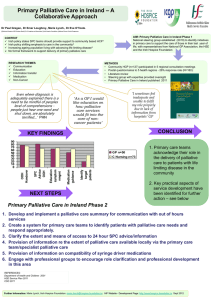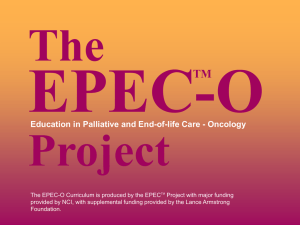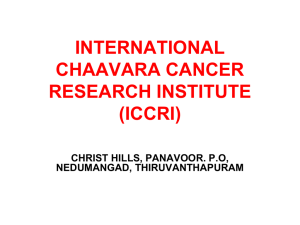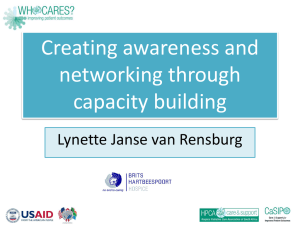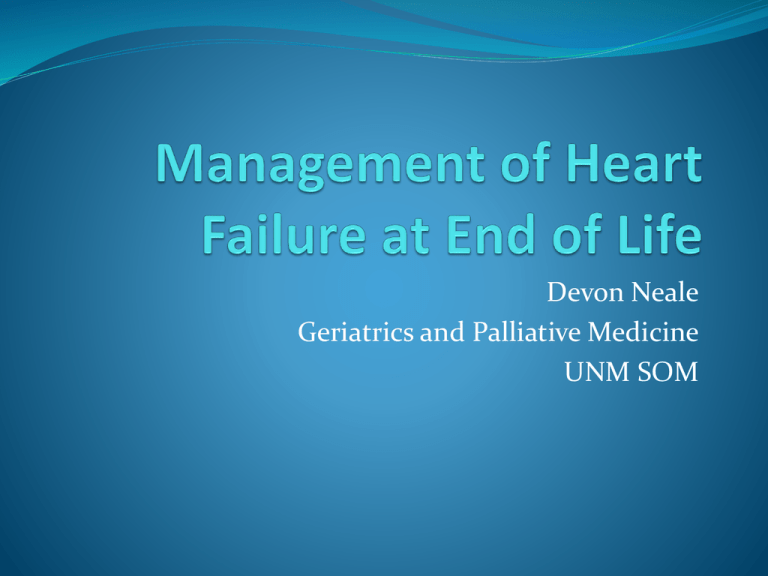
Devon Neale
Geriatrics and Palliative Medicine
UNM SOM
Objectives
To review the differences between hospice and
palliative care services
To discuss the management of symptoms commonly
experienced by heart failure patients at end of life
To address important issues in advance care planning
for patients with heart failure
Hospice care vs. Palliative care
Hospice: A health care benefit
Medicare benefit (Part A) since 1983; many private
insurances have a “hospice benefit”
Two MDs certify prognosis < 6 months if “disease runs
its usual course”
Focus is on comfort and relief of suffering, not life
prolongation
Interdisciplinary team provides care
It is not a place; primarily home-based
The Old Model of Palliative Care
Life Prolonging Care
Medicare
Hospice
Benefit
What is Palliative Care?
Palliative care as defined by WHO:
“An approach that improves the quality of life of patients and
their families facing the problems associated with life
threatening illness, through prevention of and relief of
suffering by means of early identification and impeccable
assessment and treatment of pain and other problems,
physical, psychological and spiritual”
www.capc.org
Hospice care vs. Palliative care
Palliative care
Can be provided in conjunction with life prolonging
treatment (no need to choose between treatment plans)
Does not take the place of curative care!
No prognostic requirement; no age requirement; not
limited to any specific diagnosis; not just “actively dying”
Primarily hospital-based
The goal is not to hasten nor prolong death
New Model of Palliative Care
Life Prolonging
Hospice Care
Care
Palliative Care
Why is PC important in the
management of HF?
HF is very common:
#1 cause hospitalizations in Medicare population
A leading cause of death in US
High symptom burden:
Pain, dyspnea, fatigue, edema, depression
Physical function scores 2SD below average
Symptoms are treatable
Palliative Care in HF Management
In general, PC has been demonstrated to improve patient
outcomes:
Symptom management
Quality of life
Satisfaction with care
“palliative care can be integrated with conventional HF care
that emphasizes life-prolonging treatment. This duality of
care should be considered a normal approach to patients
with HF”*
*Hauptman and Havranek, Arch Intern Med 2005
Key elements of PC for HF
Discussing prognosis and treatment options
Eliciting patient’s goals of care
Supporting advance care planning
Team-based approach to symptom management
Physical
Psychological
Emotional
Spiritual
Existential
Caregiver support
Cardiac Medications
As indicated:
Ace-inhibitor
Beta-blocker
Diuretic
Spironolactone
ALLEVIATE SYMPTOMS AND IMPROVE QoL
Prognostication in HF
Very difficult: we are unable to predict timing of
exacerbations or sudden cardiac death (up to 50% of
patients)
In general, clinicians tend to overestimate life expectancy
(by a factor of 5.3)*
Increased duration of patient-physician relationship, less
accurate prognostication
*Christakis and Lamont, BMJ 2000
Why is prognostication important?
Why is prognostication important?
Allows patients to:
Identify priorities based on life expectancy
Make informed decisions about their care
Complete advance directives and designate a PoA
Attend to legal and financial matters
Focus on life closure and legacy issues
Emphasize participation in pleasurable activities
General Statistics
New diagnosis of HF in the community:*
1yr mortality: 24%
2yr mortality: 37%
6yr mortality: 75%
50% of HF patients die within 5yrs of diagnosis
One-year mortality after first HF admission in elderly
patient with comorbidities: 60%
*Senni et al, Arch Intern Med 1999, Ho et al, Circulation 1993
Functional Capacity
The most important predictor of mortality in HF
Decline in functional capacity is associated with high 3
month mortality*
*Lunney JR, JAMA 2003
From: Patterns of Functional Decline at the End of Life
JAMA. 2003;289(18):2387-2392. doi:10.1001/jama.289.18.2387
Figure Legend:
Error bars indicate 95% confidence intervals.
Date of download: 11/13/2012
Copyright © 2012 American Medical
Association. All rights reserved.
NYHA class
NYHA class
Symptoms
1 year mortality with
optimal treatment
I
No symptoms
5-10%
II
Symptoms with
ordinary activity
5-10%
III
Marked limitation
of physical activity
10-15%
IV
Symptoms at rest
30-40%
Prognostication in HF
Poor prognostic factors:
Ischemic etiology
Recent cardiac hospitalization
High BUN, cr > 1.4, Na <135, anemia
SBP <100 or HR >100
EF <45%
Treatment resistant ventricular dysrhythmia
Cachexia
Decreased functional capacity
Liver dysfunction or delirium due to hypoperfusion
Intolerance of AceI due to hypotension
Comorbidities: DM, depression, COPD, cirrhosis, CVA,
cancer, HIV
Seattle Heart Failure Model
Calculator of projected survival at baseline and after
interventions
Based on retrospective investigation of predictors of
survival among 1,125 HF patients in PRAISE1, validated
in multiple cohorts
http://depts.washington.edu/shfm/
Hospice Eligibility
2 physicians estimate life expectancy of < 6 months if
disease “runs its usual course”
Patient elects treatment focused on comfort/QoL rather
than attempts at life-prolongation
NHPCO 1996 guidelines:
NYHA IV and optimal medical management
Secondary factors
EF <20%, Symptomatic arrythmia, History of cardiac arrest and CPR,
Unexplained syncope, CVA of cardiac origin, HIV
Symptom Management in HF
Common Symptoms in Advanced HF
Pain – 78% (as high as cancer patients)
Dyspnea – 61%
Depression – 59%
Insomnia – 45%
Anorexia – 43%
Constipation – 37%
Nausea / Vomiting – 32%
Anxiety – 30%
Pain Management
What is underlying etiology?
Angina, edema, comorbidities (OA)
Avoid NSAIDs / Cox2-inhibitors
Antagonize effects diuretics and Ace-I
Affect renal function
Increase fluid retention/ edema
Low-dose opioids:
2-5mg morphine po q2h prn
Up-titrate as needed
Stimulant laxative to prevent constipation
Dyspnea
Specific Etiologies:
Fluid overload
Pleural effusion
Pericardial effusion
Arrythmia
Management
Diuresis:
Very high doses loop
IV / SC dosing of loops
Add thiazide
HCTZ 25-100mg
Metolazone 5-20mg
Repositioning
Air circulation
Opioids
Opioids for Dyspnea in HF
Opioids affect CNS processing of input from the lungs and PNS that
leads to the sensation of dyspnea
Goal is not to stop respiration but to ease the subjective sense of
breathlessness
Patients may take slower, deeper, more effective respirations
Start low, go slow (in up-titration)
2-3mg oral morphine suspension q2h prn
Benzodiazepines may be used as adjuvant to opioids (esp if high levels
of anxiety)
Diagnosing Depression at EoL
Vegetative symptoms (decreased energy, poor sleep,
decreased appetite) may be due to underlying disease
More specific for depression at EoL:
Guilty, hopelessness, worthlessness
Treating Depression at End of Life
Short-term psychotherapy
Problem-based
Meaning-based
Dignity-based
SSRI (sertraline)
Effect in 1-2 months
Psychostimulants: use with caution in HF
Effect in days
May increase appetite, energy and mood
Unknown if increases risk of arrythmia
Ritalin 2.5 – 5mg BID (second dose early afternoon)
Advance Care Planning
Advance Care Planning
Code Status
Power of Attorney for Health Care (proxy)
Advance directive / Living Will: may include
Use of artificial nutrition and hydration
Do not hospitalize
Management of ICD
Management of pacemaker
Financial planning
Heart Failure Society of America educational module for
patients and families (high literacy level)
www.hfsa.org/pdf/module9.pdf
When to Initiate the Discussion?
At diagnosis
At decrease in functional status / progression of
disease
During hospitalization for acute exacerbation
At hospital follow-up appointment in the clinic
AT ANY TIME! IT IS A PROCESS
Code Status Discussions
Always in the setting of disease state and overall prognosis
Very important to address with patients with HF given high
rates of sudden cardiac death
Revisit the issue regularly and with significant changes in
clinical status
The alternative to resuscitation is medical care that is
entirely focused on the patient’s comfort
It is ok to give a medical opinion or recommendation
A patient with a DNR code status should have ICD
deactivated
Power of Attorney
Does not need to be a relative
Can be a verbal designation – document it
Should be someone who can respect and relay the patient’s
wishes
Once the patient identifies a PoA, it is important that they
discuss the patient’s wishes and what “quality of life” means
according to the patient.
“What have you told them (or want to tell them) about your
preferences for care?”
Surrogacy in New Mexico
If someone has decisional capacity, make decisions with
that person
“But the POAHC wants us to do x, y, z….”!
Who makes decisions for non-decisional patients?
Guardian, PoAHC
What if there is no guardian or PoAHC?
Uniform Health Care Decisions Act
http://law.justia.com/newmexico/codes/nmrc/jd_ch24art7aacff.html
Uniform Health Care Decisions Act
24-7A-5. Decisions by surrogate.
B. . . . In the absence of a designation or if the designee is not reasonably available, any
member of the following classes of the patient's family who is reasonably available, in
descending order of priority, may act as surrogate:
(1)
the spouse, unless legally separated or unless there is a pending
petition for annulment, divorce, dissolution of marriage or legal
separation;
(2) an individual in a long-term relationship of indefinite
duration with the patient in which the individual has demonstrated an
actual commitment to the patient similar to the commitment of a
spouse and in which the individual and the patient consider themselves
to be responsible for each other's well-being;
(3) an adult child;
(4) a parent;
(5) an adult brother or sister; or
(6) a grandparent.
Uniform Health Care Decisions Act
If none of the individuals eligible to act as
surrogate . . . is reasonably available,
an adult who has exhibited special care and
concern for the patient, who is familiar with the
patient’s personal values and who is reasonably
available may act as surrogate
Role of the PoAHC
To reflect the wishes of the patient, not what they (PoAHC)
would want if in that situation
Never ask “what do you want us to do?” Ask “Have you ever
had conversations with your father about his wishes if he
were in this situation?” (other relatives illness, Terry Schiavo)
Ask “what would your father say if he heard this information
that you just heard, and could talk with us?”
Quality of Life
“Tell me a little about your father. What was
important to him?”
“What made life worth living to your father?”
“What would he think of his current QoL?”
“Do you think he would want his current QoL
prolonged?”
Informed Decision-making
Make sure you have explained the diagnosis,
treatment options, and prognosis to the best of your
ability before you ask PoAHC to make a decision
(informed consent)
Advance Directives
Purpose is to ensure that the patient’s wishes are respected
A “gift” to the PoA / patient’s family
Minimize burden of “decision-making”
Decreases conflict among family members
Establishes trust between the patient and the medical
system
In New Mexico: Written instructions signed and dated, no
lawyer or notary necessary
Advance Directive
May include preferences regarding:
Use of intubation and cardiac resuscitation
Use of minimally invasive ventilation (Bipap)
Use of surgery or other invasive therapies
Use of artificial nutrition and hydration
Time-limited trials of therapies
Use of pacemaker or ICD
Deactivation of ICD
Deactivation of ICD
Approximately 20% of patients with ICD are shocked
within the last weeks of life: painful and decreases QoL
Deactivation is legal and ethical: like refusal or
discontinuation of any medical therapy
Most patients do not know ICD’s can be deactivated and do
not require removal
The defibrillating/shocking capacity can be discontinued
separately from the pacemaker function
American College of Cardiology
Expert Consensus Statement on the Management of
Cardiovascular Implantable Electronic Devices in Patients
Nearing EOL or requesting withdrawal of therapy:
Review legal, ethical, religious principles of withdrawal of
life-sustaining therapies
Highlight importance of proactive communication to reduce
suffering at EOL
Provide management scheme to guide clinicians in process
deactivation
Deactivation of Pacemakers
Rarely necessary
Usually the stressed myocardium does not respond to
pacemaker stimuli at EOL
Situations in which quality of life is so poor (severe
dementia) that any measures to prolong life are
discontinued
Summary
Patients with advanced disease can receive palliative
care at any time, hospice care when prognosis is <6
months
Prognostication in HF is difficult, there are models
Opioids are an important therapy for dyspnea
Advanced Care Planning is a process
Deactivation of ICD’s should be addressed
Resources:
Fast facts: http://www.eperc.mcw.edu
Brief answers to >200 palliative questions / topics
Heart Failure Society of America: www.hfsa.org
Information for clinicians and patients/families
“Palliative Care for Patients with Heart Failure”
Pantilat and Steimle, JAMA 2004
UNM Inpatient Palliative Care Consult: x24868
Questions or Comments?
Dneale@salud.unm.edu


